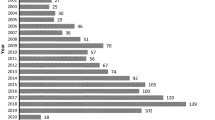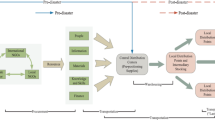Abstract
In this paper, a mixed-integer linear programming model is discussed to provide joint decision making for facility location and production–distribution across countries for both forward and reverse logistics. A hybrid facility network is considered for cost-cutting and equipment sharing where the facilities of forward logistics are also equipped to provide reverse logistics services. The model considers the dynamic production and storage capacity of the facilities which can be expanded if required. Furthermore, the effectiveness of the model is tested to deal with disruptions due to man-made or natural disasters. The dynamic facility allocation enables the model to withstand the demand/supply disruptions in a disaster-affected zone. Besides this, the model considers carbon emissions caused due to manufacturing, remanufacturing, repair, storage and transportation. These emissions are regulated using cap and trade policy Thus, the proposed model balances resilience and sustainability under uncertain market demand and product returns. The chance-constrained approach is used to obtain the deterministic equivalence of the stochastic demand and returns. The paper also investigates the changes in emission and production level in each country under demand and supply disruptions. The parameters of the model are mapped with the various dimensions of big data such as volume, velocity and variety. The proposed model is solved using randomly generated data sets having realistic parameters with essential big data characteristics.












Similar content being viewed by others
References
Afesorgbor, S. K., & Demena, B. A. (2019). The effect of trade on the environment: Evidence from meta-analysis. Meta-Analysis Economic Research Network (MAER-Net) conference, Australia. https://ageconsearch.umn.edu/record/291225/files/Abstracts_19_05_06_12_09_22_35__131_104_23_13_0.pdf.
Aggarwal, R. (2018). A chance constraint based low carbon footprint supply chain configuration for an FMCG product. Management of Environmental Quality: An International Journal, 29(6), 1002–1025.
Amin, S. H., & Baki, F. (2017). A facility location model for global closed-loop supply chain network design. Applied Mathematical Modelling, 41, 316–330.
BBC News (2011). Japan disaster: Supply shortages in three months. Retrieved December 8, 2019, from http://www.bbc.com/news/business-12782566.
Cardoso, S. R., Paula Barbosa-Póvoa, A. P., Relvas, S., & Novais, A. Q. (2015). Resilience metrics in the assessment of complex supply-chains performance operating under demand uncertainty. Omega, 56, 53–73.
Cavalcante, I. M., Frazzon, E. M., Forcellini, F. A., & Ivanov, D. (2019). A supervised machine learning approach to data-driven simulation of resilient supplier selection in digital manufacturing. International Journal of Information Management, 49, 86–97.
Charnes, A., & Cooper, W. W. (1959). Chance-constrained programming. Management Science, 6(1), 73–79.
Chen, H., Chiang, R. H., & Storey, V. C. (2012). Business intelligence and analytics: From big data to big impact. MIS Quarterly, 36(4), 1165–1188.
Dubey, R., Gunasekaran, A., Childe, S. J., Papadopoulos, T., Luo, Z., Wamba, S. F., et al. (2017). Can big data and predictive analytics improve social and environmental sustainability? Technological Forecasting and Social Change, 144, 534–545.
Elluru, S., Gupta, H., Kaur, H. & Singh, S. P. (2017). Proactive and reactive models for disaster resilient supply chain. Annals of Operations Research, 283(1–2), 199–224.
Fareeduddin, M., Hassan, A., Syed, M. N., & Selim, S. Z. (2015). The impact of carbon policies on closed-loop supply chain network design. Procedia CIRP, 26, 335–340.
Gao, N., & Ryan, S. M. (2014). Robust design of a closed-loop supply chain network for uncertain carbon regulations and random product flows. EURO Journal on Transportation and Logistics, 3(1), 5–34.
Giri, B. C., & Bardhan, S. (2015). Coordinating a supply chain under uncertain demand and random yield in presence of supply disruption. International Journal of Production Research, 53, 5070–5084.
Goh, M., Lim, J. Y., & Meng, F. (2007). A stochastic model for risk management in global supply chain networks. European Journal of Operational Research, 182, 164–173.
Haddadsisakht, A., & Ryan, S. M. (2018). Closed-loop supply chain network design with multiple transportation modes under stochastic demand and uncertain carbon tax. International Journal of Production Economics, 195, 118–131.
Han, X., Chen, D., Chen, D., & Long, H. (2015). Strategy of production and ordering in closed-loop supply chain under stochastic yields and stochastic demands. International Journal of U-and E-Service, Science and Technology, 8, 77–84.
Hazen, B. T., Skipper, J. B., Ezell, J. D., & Boone, C. A. (2016). Big Data and predictive analytics for supply chain sustainability: A theory-driven research agenda. Computers & Industrial Engineering, 101, 592–598.
He, J., Alavifard, F., Ivanov, D., & Jahani, H. (2019). A real-option approach to mitigate disruption risk in the supply chain. Omega, 88, 133–149.
Hosseini, S., Ivanov, D., & Dolgui, A. (2019). Review of quantitative methods for supply chain resilience analysis. Transportation Research Part E: Logistics and Transportation Review, 125, 285–307.
Huffington Post, (2015). Toyota among Japanese automaker extending plant closures. Retrieved December 15, 2019, from https://www.autoblog.com/2011/03/17/japanese-automakers-extending-plantclosures.
Ivanov, D. (2018). Revealing interfaces of supply chain resilience and sustainability: A simulation study. International Journal of Production Research, 56(10), 3507–3523.
Ivanov, D., & Dolgui, A. (2019). Low-Certainty-Need (LCN) supply chains: a new perspective in managing disruption risks and resilience. International Journal of Production Research, 57(15–16), 5119–5136.
Ivanov, D., Dolgui, A., Das, A., & Sokolov, B. (2019a). Digital supply chain twins: Managing the ripple effect, resilience, and disruption risks by data-driven optimization, simulation, and visibility. In D. Ivanov, A. Dolgui, & B. Sokolov (Eds.), Handbook of ripple effects in the supply chain (pp. 309–332). Cham: Springer.
Ivanov, D., Dolgui, A., & Sokolov, B. (2019b). The impact of digital technology and industry 4.0 on the ripple effect and supply chain risk analytics. International Journal of Production Research, 57(3), 829–846.
Ivanov, D., Dolgui, A., Sokolov, B., & Ivanova, M. (2017). Literature review on disruption recovery in the supply chain. International Journal of Production Research, 55(20), 6158–6174.
Jabbarzadeh, A., Fahimnia, B., & Sabouhi, F. (2018). Resilient and sustainable supply chain design: sustainability analysis under disruption risks. International Journal of Production Research, 56(17), 5945–5968.
Jabbarzadeh, A., Fahimnia, B., Sheu, J. B., & Moghadam, H. S. (2016). Designing a supply chain resilient to major disruptions and supply/demand interruptions. Transportation Research Part B: Methodological, 94, 121–149.
Kaur, H., & Singh, S. P. (2018). Heuristic Modelling for sustainable procurement and logistics in a supply chain using big data. Computers & Operations Research, 98, 301–321.
Kleindorfer, P. R., & Saad, G. H. (2005). Managing disruption risks in supply chains. Production and Operations Management, 14, 53–68.
Kwon, O., Lee, N., & Shin, B. (2014). Data quality management, data usage experience and acquisition intention of big data analytics. International Journal of Information Management, 34(3), 387–394.
Lamba, K., & Singh, S. P. (2017). Big data in operations and supply chain management: Current trends and future perspectives. Production Planning & Control, 28(11–12), 877–890.
Lamba, K., & Singh, S. P. (2019). Dynamic supplier selection and lot-sizing problem considering carbon emissions in a big data environment. Technological Forecasting and Social Change, 144, 573–584.
Lamba, K., Singh, S. P., & Mishra, N. (2019). Integrated decisions for supplier selection and lot-sizing considering different carbon emission regulations in big data environment. Computers & Industrial Engineering, 128, 1052–1062.
Li, Y. (2019). Saudi oil production cut by 50% after drones attack crude facilities. Retrieved January 6, 2020, from CNBC report: https://www.cnbc.com/2019/09/14/saudi-arabia-is-shutting-down-half-of-its-oil-production-after-drone-attack-wsj-says.html.
Liao, T. Y. (2018). Reverse logistics network design for product recovery and remanufacturing. Applied Mathematical Modelling, 60, 145–163.
Mikhail, M., El-Beheiry, M. & Afia, N. (2019). Investigating resilient supply chain design determinants using Monte Carlo simulation. In 2019 8th international conference on industrial technology and management (ICITM) (pp. 27–31). IEEE.
Min, H., & Ko, H. J. (2008). The dynamic design of a reverse logistics network from the perspective of third-party logistics service providers. International Journal of Production Economics, 113(1), 176–192.
Mishra, S. & Singh, S. P. (2019a). An environmentally sustainable manufacturing network model under an international ecosystem. Clean Technologies and Environmental Policy, 21(6), 1237–1257.
Mishra, S., & Singh, S. P. (2019b). Distribution network model using big data in an international environment. Science of the Total Environment. https://doi.org/10.1016/j.scitotenv.2019.135549.
Özceylan, E., Demirel, N., Çetinkaya, C., & Demirel, E. (2017). A closed-loop supply chain network design for automotive industry in Turkey. Computers & Industrial Engineering, 113, 727–745.
Panetto, H., Iung, B., Ivanov, D., Weichhart, G., & Wang, X. (2019). Challenges for the cyber-physical manufacturing enterprises of the future. Annual Reviews in Control, 47, 200–213.
Papadopoulos, T., Gunasekaran, A., Dubey, R., Altay, N., Childe, S. J., & Fosso-Wamba, S. (2017). The role of big data in explaining disaster resilience in supply chains for sustainability. Journal of Cleaner Production, 142, 1108–1118.
Pavlov, A., Ivanov, D., Pavlov, D., & Slinko, A. (2019). Optimization of network redundancy and contingency planning in sustainable and resilient supply chain resource management under conditions of structural dynamics. Annals of Operations Research. https://www.autoblog.com/2011/03/17/japanese-automakers-extending-plantclosures.
Prasad, S., Zakaria, R., & Altay, N. (2018). Big data in humanitarian supply chain networks: A resource dependence perspective. Annals of Operations Research, 270(1–2), 383–413.
Reddy, K. N., Kumar, A. & Ballantyne, E. E. (2018). A three-phase heuristic approach for reverse logistics network design incorporating carbon footprint. International Journal of Production Research, 57(19), 6090–6114.
Shuang, Y., Diabat, A., & Liao, Y. (2019). A stochastic reverse logistics production routing model with emissions control policy selection. International Journal of Production Economics, 213, 201–216.
Snyder, L. V., Atan, Z., Peng, P., Rong, Y., Schmitt, A. J., & Sinsoysal, B. (2016). OR/MS models for supply chain disruptions: A review. IIE Transactions, 48, 89–109.
Song, M., Cen, L., Zheng, Z., Fisher, R., Liang, X., Wang, Y., et al. (2017). How would big data support societal development and environmental sustainability? Insights and practices. Journal of Cleaner Production, 142, 489–500.
Song, M. L., Fisher, R., Wang, J. L., & Cui, L. B. (2018). Environmental performance evaluation with big data: Theories and methods. Annals of Operations Research, 270(1–2), 459–472.
Song, M., & Wang, S. (2018). Market competition, green technology progress and comparative advantages in China. Management Decision, 56(1), 188–203.
Tao, Z. G., Guang, Z. Y., Hao, S., & Song, H. J. (2015). Multi-period closed-loop supply chain network equilibrium with carbon emission constraints. Resources, Conservation and Recycling, 104, 354–365.
The Emission Gap Report (2017). A UN environment synthesis report. Retrieved January 6, 2020, from https://wedocs.unep.org/bitstream/handle/20.500.11822/22070/EGR_2017.pdf.
UN report: Time to seize opportunity, tackle challenge of e-waste, (2019). Retrieved January 6, 2020, from https://www.unenvironment.org/news-and-stories/press-release/un-report-time-seizeopportunity-tackle-challenge-e-waste.
Wang, J., Su, K., & Wu, Y. (2018). The reliable facility location problem under random disruptions. Wireless Personal Communications, 102(4), 2483–2497.
Xu, L., & Wang, C. (2017). Sustainable manufacturing in a closed-loop supply chain considering emission reduction and remanufacturing. Resources, Conservation and Recycling, 131, 297–304.
Yu, M., & Cruz, J. M. (2018). The sustainable supply chain network competition with environmental tax policies. International Journal of Production Economics, 217, 218–231.
Zhang, Y., Alshraideh, H., & Diabat, A. (2018). A stochastic reverse logistics production routing model with environmental considerations. Annals of Operations Research, 271(2), 1023–1044.
Zhao, R., Liu, Y., Zhang, N., & Huang, T. (2017). An optimization model for green supply chain management by using a big data analytic approach. Journal of Cleaner Production, 142, 1085–1097.
Zhong, R. Y., Newman, S. T., Huang, G. Q., & Lan, S. (2016). Big Data for supply chain management in the service and manufacturing sectors: Challenges, opportunities, and future perspectives. Computers & Industrial Engineering, 101, 572–591.
Acknowledgements
The authors thank the UKEIRI-UGC and Department of Science and Technology, Ministry of Science and Technology, New Delhi, India for funding this research.
Author information
Authors and Affiliations
Corresponding author
Additional information
Publisher's Note
Springer Nature remains neutral with regard to jurisdictional claims in published maps and institutional affiliations.
Electronic supplementary material
Below is the link to the electronic supplementary material.
Rights and permissions
About this article
Cite this article
Mishra, S., Singh, S.P. A stochastic disaster-resilient and sustainable reverse logistics model in big data environment. Ann Oper Res 319, 853–884 (2022). https://doi.org/10.1007/s10479-020-03573-0
Published:
Issue Date:
DOI: https://doi.org/10.1007/s10479-020-03573-0




